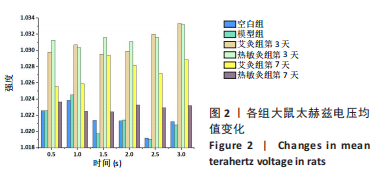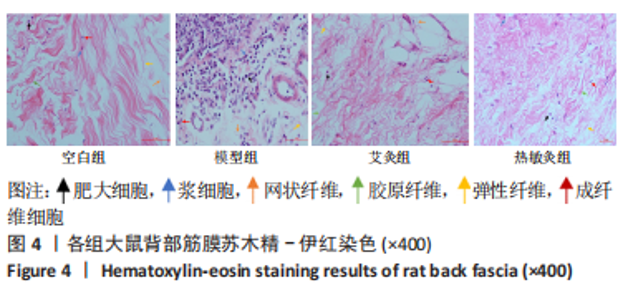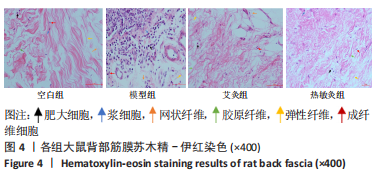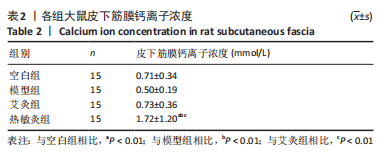[1] 陈朝霞,李萍,张广中,等.艾灸治疗血瘀证斑块型银屑病:随机对照研究[J].中国针灸,2021,41(7):762-766.
[2] 马瑜婕.针灸综合治疗(轻中度)斑块型银屑病的临床研究[D].北京:北京中医药大学,2021.
[3] 吴慧婷,崔田田,欧阳厚淦,等.不同疗程热敏灸干预骨质疏松症模型大鼠穴位周围结缔组织及脊髓的形态学变化[J].中国组织工程研究,2020,24(20):3135-3139.
[4] 赵丽云,张铭,赵福建,等.筋膜与经络研究进展[J].中华中医药杂志,2011,26(8):671-675.
[5] 田宁,陈日新,谢兵,等.支气管哮喘患者热敏穴红外辐射特征研究[J].上海针灸杂志,2014,33(2):174-176.
[6] NAGEL M, BOLIVAR PH, BRUCHERSEIFER M, et al. Integrated planar terahertz resonators for femtomolar sensitivity label-free detection of DNA hybridization. Appl Opt. 2002;41(10):2074-2078.
[7] 范志文,张敬文,邱烈泽,等.人体中渚穴、合谷穴与非经穴外劳宫的太赫兹波特征研究[J].中华中医药杂志,2019,34(7):3009-3011.
[8] 薄文斐,车嵘,孔磊,等.红外及太赫兹辐照下细胞膜生物效应的研究进展[J].物理学报,2021,70(24):248707.
[9] DENG Y, YI S, LIN Y, et al. Influence of needling the foot-yangming points on intracellular Ca2+ concentration in smooth muscles of the gastric antrum in rabbits. J Tradit Chin Med. 2007;27(1):65-69.
[10] 罗汀,郭义,王秀云.经络循行生化研究近况[J].上海针灸杂志, 2006,25(6):45-47.
[11] 汪家柔.艾灸肺俞、肝俞穴对穴位电流及相关脏器钙离子分布的影响研究[D].北京:北京中医药大学,2009.
[12] 高扬,孙文,高艳峰,等.银屑1号下调小鼠银屑病模型炎性因子及NF-κB表达的调控机制[J].中国皮肤性病学杂志,2017,31(10): 1131-1134.
[13] CHEN RX, LV ZM, CHEN MR, et al. Stroke treatment in rats with tail temperature increase by 40-min moxibustion. Neurosci Lett. 2011; 503(2):131-135.
[14] 陈日新,康明非.腧穴热敏化的临床应用[J].中国针灸,2007,27(3): 199-202.
[15] 陈日新,康明非,陈明人.岐伯归来——论腧穴“敏化状态说” [J].中国针灸,2011,31(2):134-138.
[16] 钱存泽,钱进,白耀辉.近红外仿灸仪的研制与临床应用[J].红外技术,1991,13(6):27-32.
[17] 王金海,赵天平,吴焕淦,等.艾烟临床安全性评价的思考[J].上海针灸杂志,2010,29(1): 6-8.
[18] 白耀辉,林文任.艾灸与温热刺激关系的探讨[J].针灸学报,1991, 7(4):10-11.
[19] 丁光宏,沈雪勇,褚君浩,等.人体穴位与中医各种灸的红外辐射光谱特性[J].针刺研究,2002,27(4):269-273.
[20] 邓海平,沈雪勇,丁光宏.艾灸与经络穴位红外辐射特性[J].中国针灸,2004,24(2):33-35.
[21] 黄志军,邱烈泽,章文春.艾灸右内关穴对双侧劳宫穴太赫兹波辐射光谱的影响[J].江西中医药大学学报,2019,31(5):55-57.
[22] 张舟南,李姝池,邱烈泽,等.人体腧穴与隔姜灸、温和灸、雀啄灸的太赫兹光谱特征[J].中华中医药杂志,2019,34(10):4828-4831.
[23] YANG X, ZHAO X, YANG K, et al. Biomedical Applications of Terahertz Spectroscopy and Imaging. Trends Biotechnol. 2016;34(10):810-824.
[24] 张恭,王斐,刘荣.太赫兹技术在医学领域的应用与展望[J].遥测遥控,2021,42(4):36-44.
[25] TITOVA LV, AYESHESHIM AK, GOLUBOV A, et al. Intense THz pulses down-regulate genes associated with skin cancer and psoriasis: a new therapeutic avenue? Sci Rep. 2013;3:2363.
[26] QI M, LIU R, LI B, et al. Behavioral Effect of Terahertz Waves in C57BL/6 Mice. Biosensors (Basel). 2022;12(2):79.
[27] 王美君,凌梦怡,肖荷,等.太赫兹波辐射对小鼠造血功能的影响[J].激光与光电子学进展,2020,57(13):271-278.
[28] 赵娜.胃癌组织的太赫兹光谱特性研究[D].杭州:中国计量大学, 2016.
[29] 张逸.基于太赫兹时域光谱的生物组织病变检测方法研究[D].杭州:浙江大学,2018.
[30] 王丹.太赫兹时域光谱测量冠心病患者血液中甘油三酯含量的研究[D].南京:东南大学,2021.
[31] 余晓,杨帆.太赫兹成像技术用于皮肤烧伤检测的研究进展[J].太赫兹科学与电子信息学报,2021,19(2):201-209.
[32] 郭寒,杨威,夏成,等.血小板与钙离子信号的研究进展[J].动物医学进展,2019,40(1):84-87.
[33] 朱宇,何易晓,杨丽娟,等.钙离子稳态失调与癌症增殖转移关系的研究进展[J].昆明医科大学学报,2017,38(3):139-142.
[34] 高婧晗,刘飞,杨晓蕾,等.钙离子稳态的调控在糖尿病相关心房颤动中的作用[J].心血管病学进展,2021,42(10):888-891.
[35] AHN BK, JEONG SK, LEE SH. Role of PKC-delta as a signal mediator in epidermal barrier homeostasis. Arch Dermatol Res. 2007;299(2):53-57.
[36] LEE SE, LEE SH. Skin Barrier and Calcium. Ann Dermatol. 2018;30(3): 265-275.
[37] ELSHOLZ F, HARTENECK C, MULLER W, et al. Calcium--a central regulator of keratinocyte differentiation in health and disease. Eur J Dermatol. 2014;24(6):650-661.
[38] 黄海勇,黄功华,刘新光.角质形成细胞在银屑病中作用的研究进展[J].中国免疫学杂志,2020,36(12):1527-1530.
[39] 景丹丹,李忠仁.钙离子生物活性与针刺调节作用的研究进展[J].北京中医药,2008,27(8):663-665.
[40] 杜娟,周立华.浅论循经部位高能量代谢的形成机制[J].中国针灸, 2014,34(11):1119-1121.
[41] 陈知水,杨萍,陈旭阳,等.经络系统—人体生物电离子通路网络的探讨[J].亚太传统医药,2006,2(2):49-53.
[42] 欧阳彦楚.基于三焦焦膜实质对热敏灸治疗银屑病机制的实验研究[D].南昌:江西中医药大学,2020.
[43] 陈楚,欧阳厚淦,齐艳喆,等.热敏灸手少阳三焦经可改善银屑病样大鼠模型的皮损病变[J].中国组织工程研究,2022,26(35):5602-5606.
[44] GUO L, BO W, WANG K, et al. Theoretical investigation on the effect of terahertz wave on Ca(2+) transport in the calcium channel. iScience. 2021;25(1):103561.
[45] 郭义,张艳军,王秀云,等.基于生物化学对经络腧穴与钙离子相关性的研究[J].世界中医药,2020,15(7): 970-975.
|









